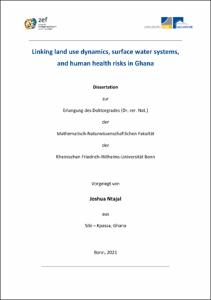Ntajal, Joshua: Linking land use dynamics, surface water systems, and human health risks in Ghana. - Bonn, 2022. - Dissertation, Rheinische Friedrich-Wilhelms-Universität Bonn.
Online-Ausgabe in bonndoc: https://nbn-resolving.org/urn:nbn:de:hbz:5-67343
Online-Ausgabe in bonndoc: https://nbn-resolving.org/urn:nbn:de:hbz:5-67343
@phdthesis{handle:20.500.11811/10120,
urn: https://nbn-resolving.org/urn:nbn:de:hbz:5-67343,
author = {{Joshua Ntajal}},
title = {Linking land use dynamics, surface water systems, and human health risks in Ghana},
school = {Rheinische Friedrich-Wilhelms-Universität Bonn},
year = 2022,
month = jul,
note = {Human-land use-water interactions are multifaceted with crucial influences on the transmission of water-related infectious diseases, via ingestion of polluted water or human-skin contacts with infected water bodies. Water pollution is a persistent challenge in the Greater Accra Metropolitan Area in Ghana, which contributes to water-related infectious disease outbreaks. However, the existing interventions are fragmented and have often failed, while diseases continue to pose huge burdens on households and the government. Further, the underlying drivers of exposure and risks of diseases are not explored and explicitly understood, due to lack of institutional collaborations. Therefore, this doctoral research aims at enhancing the understanding of the human-water-health nexus, focusing on the exposure pathways and risks of water-related infectious diseases, including water-borne diseases and urinary schistosomiasis in the Greater Accra Metropolitan Area. This research is based on the hypothesis that human-land use-water interactions have linkages with water-related infectious diseases, which require the integration of multi-methods to comprehensively explore and examine the underlying drivers to enhance understanding and support develop integrated and collaborative strategies.
The study employed a mixed-methods approach and stakeholder participation by integrating a systematic literature review, field observations, focus group discussions, workshops, and expert elicitations. Data integration and analysis employed qualitative system dynamic modeling, land use and land cover change assessment, and bivariate logistic regression analysis. The key outcomes of the study revealed explicit linkages between human–water interaction patterns and the transmission of schistosomiasis, and complex linkages between land use and water-borne disease transmission, due to multiple underlying drivers.
Further, it was found that provisioning only water and sanitation is insufficient to eliminate diseases as water-borne diseases are still prevalent, given access to water and sanitation. Flooding, influenced by poor land use planning and solid waste disposal is a crucial contributing factor to diarrheal disease outbreaks. The risk of urinary schistosomiasis is linked to limited access to improved sanitation and safe water supply, open defecation, and human water-contact patterns. This doctoral study contributes to multi-sectoral collaborations through the development of integrated and collaborative strategies, including land use plans, human behavioral change, flood risk reduction, improved waste management, and water quality monitoring to be inclusively implemented at the community, district, metropolitan, and national levels to reduce the risks of diseases and promote a clean environment and human health.},
url = {https://hdl.handle.net/20.500.11811/10120}
}
urn: https://nbn-resolving.org/urn:nbn:de:hbz:5-67343,
author = {{Joshua Ntajal}},
title = {Linking land use dynamics, surface water systems, and human health risks in Ghana},
school = {Rheinische Friedrich-Wilhelms-Universität Bonn},
year = 2022,
month = jul,
note = {Human-land use-water interactions are multifaceted with crucial influences on the transmission of water-related infectious diseases, via ingestion of polluted water or human-skin contacts with infected water bodies. Water pollution is a persistent challenge in the Greater Accra Metropolitan Area in Ghana, which contributes to water-related infectious disease outbreaks. However, the existing interventions are fragmented and have often failed, while diseases continue to pose huge burdens on households and the government. Further, the underlying drivers of exposure and risks of diseases are not explored and explicitly understood, due to lack of institutional collaborations. Therefore, this doctoral research aims at enhancing the understanding of the human-water-health nexus, focusing on the exposure pathways and risks of water-related infectious diseases, including water-borne diseases and urinary schistosomiasis in the Greater Accra Metropolitan Area. This research is based on the hypothesis that human-land use-water interactions have linkages with water-related infectious diseases, which require the integration of multi-methods to comprehensively explore and examine the underlying drivers to enhance understanding and support develop integrated and collaborative strategies.
The study employed a mixed-methods approach and stakeholder participation by integrating a systematic literature review, field observations, focus group discussions, workshops, and expert elicitations. Data integration and analysis employed qualitative system dynamic modeling, land use and land cover change assessment, and bivariate logistic regression analysis. The key outcomes of the study revealed explicit linkages between human–water interaction patterns and the transmission of schistosomiasis, and complex linkages between land use and water-borne disease transmission, due to multiple underlying drivers.
Further, it was found that provisioning only water and sanitation is insufficient to eliminate diseases as water-borne diseases are still prevalent, given access to water and sanitation. Flooding, influenced by poor land use planning and solid waste disposal is a crucial contributing factor to diarrheal disease outbreaks. The risk of urinary schistosomiasis is linked to limited access to improved sanitation and safe water supply, open defecation, and human water-contact patterns. This doctoral study contributes to multi-sectoral collaborations through the development of integrated and collaborative strategies, including land use plans, human behavioral change, flood risk reduction, improved waste management, and water quality monitoring to be inclusively implemented at the community, district, metropolitan, and national levels to reduce the risks of diseases and promote a clean environment and human health.},
url = {https://hdl.handle.net/20.500.11811/10120}
}






